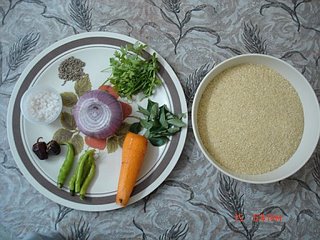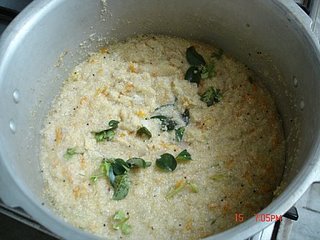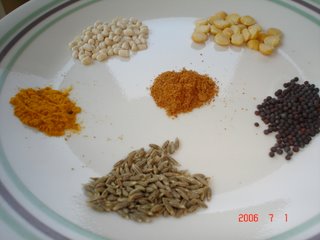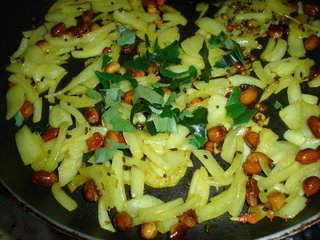Dear foodies,
Weekday mornings are a rush to get out of the house with breakfast being a speed bump in the process. Weekends on the other hand are days when I relax and cook a leisurely breakfast which more often that not ends up being brunch if we are lucky or a very late lunch. The food typically served for breakfast/tiffin in India are some of my all time favorite foods. Indians detest sweet things first thing in the morning have come up with a myriad choice of delectable savory foods to kick start the day. A variety of dosa's, idli, upma, puri and all the condiments that go with each one of them are fabulous examples of Indian home cooking. Tiffin is the colloquial name given to these meals - a light meal that could be perfect for breakfast or a mid-day snack.
Upma, for those unfamiliar with the dish, is a savory porridge made from Semolina/Rava/Sooji. The word upma/uppindi (Tamil/Telugu) comes from: uppu -salt, maavu/pindi - flour, combining to mean seasoned flour. But don't be fooled by its humble name, made well it could be an explosion of flavors & textures. This is also the famed dish that got Floyd Cardoz his final win on Top Chef Masters! Upma is traditionally a breakfast item and has as many variations are there are cooks. It can be made rich & divine by cooking it with ghee and toasted cashews (jeedipappu upma) or made healthy & colorful with seasonal vegetables. Wrapped inside a pesarattu (green lentil dosa) it's bound to make you take long nap :)
Upma begins with the rava/semolina lightly toasted in a pan and reserved. Ghee/oil is then seasoned with mild spices, veggies of choice and water are added and the whole thing is brought to a rolling boil. Rava is then slowly streamed into the seasoned water and allowed to steam for a few minutes. Served with a tiny dollop of ghee this is divine! This basic recipe evolved and transformed into many delectable variations that use ground whole wheat (dalia), vermicelli, noodles, poha (flattenned rice), oats, tapioca pearls/sago, bread and even left over idli's. There might well be other variations that I'm not aware of.
At home, my mom is the go-to person for all things upma, well all things food! But bread upma, as far as I remember has been my Dad's domain (I know I'm going to hear about this). This is probably one of the few dishes I've seen him help out with consistently over the years. He came up with this neat technique to transform dry, stale bread into tender, flavorful chunks by sprinkling buttermilk over the bread cubes. It instantaneously gives it tang, very much like sourdough and makes the bread tender and moist again. And once you have buttermilk as the vehicle you can enhance the flavor with a dash of chilli powder, some turmeric for color, a few pinches of tandoori masala/garam masala or any other spice mix of choice. So if you have stale bread lying around this is the perfect way to use it up.
At home, my mom is the go-to person for all things upma, well all things food! But bread upma, as far as I remember has been my Dad's domain (I know I'm going to hear about this). This is probably one of the few dishes I've seen him help out with consistently over the years. He came up with this neat technique to transform dry, stale bread into tender, flavorful chunks by sprinkling buttermilk over the bread cubes. It instantaneously gives it tang, very much like sourdough and makes the bread tender and moist again. And once you have buttermilk as the vehicle you can enhance the flavor with a dash of chilli powder, some turmeric for color, a few pinches of tandoori masala/garam masala or any other spice mix of choice. So if you have stale bread lying around this is the perfect way to use it up.
Bread UpmaPrep Time - 15mins
Cook time - 20minsServings - 3
- 10-12 slices - day old bread slices (any kind would work)
- 1/4 cup - Yogurt/Curd, homemade or store-bought
- 1/2 cup - Water
- a pinch of Turmeric
- 1/4 tsp - Red Chilli powder (optional)
- 1/4 tsp - Garam Masala/Tandoori Masala/Sambar Powder/Coriander Powder (optional)
- Salt to taste
Method:
- 1" round of Ginger, thinly sliced or grated
- 1/2 cup - Onions, sliced
- 3/4 cup - Tomatoes, cubed
- 1-2 - Green chiles, slit or 1/2 tsp - Red chilli powder
- 1/4 tsp - Garam Masala/Tandoori Masala (optional)
- 1/8 tsp - Turmeric
- pinch of Asafoetida/Hing
- 1/2 tsp - Mustard seeds
- 1/2 tsp - Cumin seeds
- 1/2 tsp - Urad/Channa dal
- 6-8 - Curry leaves
- 2 Tbsp - Oil
- Prepare your vegetables first, have everything sliced and ready to go. In a bowl whisk together yogurt, water and seasonings. Spread bread cubes on a wide platter and sprinkle the seasoned buttermilk as evenly as possible over all them. You don't want them to be entirely soaked in buttermilk but just barely moist, so use as much or little as needed.
- Heat oil in a wide, shallow pan and add mustard seeds, cumin and dals. Once the seeds begin to splutter, add turmeric powder, hing, onions, curry leaves, ginger and slit green chillies. Sprinkle some salt on the onions and cook until they are softened slightly.
- Add cubed tomatoes and cook until they begin to fall apart and become mushy. Add the spice powders next, if using.
- Carefully stir in bread cubes, coating them with the onion-tomato gravy without breaking them up. Increase heat to medium high and spread them out in a uniform layer so they can cook and char around the edges a bit. Cook undisturbed for 2-3 mins and then carefully stir so the other side chars as well. This is crucial step that adds needed texture to the otherwise mushy center of the bread cubes.
- Finally garnish with cilantro and serve hot with some tomato ketchup & lime/lemon wedges on the side.
This is a quick, filling breakfast to make and that will leave you with more time devour weekend newspapers and channel surf. Its a great way to use up stale bread lying around on the kitchen counter as well so you can stock up again for the week ahead. Fresh green peas are in season now and they would be great in this upma, and so would grated carrots or roasted peanuts.
Citrus fruit & Berrries are back in season again!
On another note, my camera gave up on me last week! :( An Err99 message showed up and after much anguish we found out that the shutter needs to be replaced. I am planning to upgrade to another camera instead of investing more on the old one (Rebel XSi). I am leaning towards a Canon T3i/600D but haven't decided yet, any inputs/tips/advice ?







 I've talked a lot about upma's here -
I've talked a lot about upma's here - 
 I love peanuts, and...I love this upma :D This is one of my favorite weekend brunches, if I remember to soak the sabudana the previous night that is :) Its fun to eat this upma, the sago is slightly chewy and the peanuts crunchy, giving this dish a perfect balance of textures. Its a very simple dish with just two main components apart from the tadka/seasoning. Once you have the pre-soaked sabudana it hardly takes more than 15-20 mins to put the dish together. I bought some organic, roasted peanuts (unsalted) from the bulk bins of my local store and that shortened the prep time even more. If roasting them, make extra and store them for later use.
I love peanuts, and...I love this upma :D This is one of my favorite weekend brunches, if I remember to soak the sabudana the previous night that is :) Its fun to eat this upma, the sago is slightly chewy and the peanuts crunchy, giving this dish a perfect balance of textures. Its a very simple dish with just two main components apart from the tadka/seasoning. Once you have the pre-soaked sabudana it hardly takes more than 15-20 mins to put the dish together. I bought some organic, roasted peanuts (unsalted) from the bulk bins of my local store and that shortened the prep time even more. If roasting them, make extra and store them for later use.














